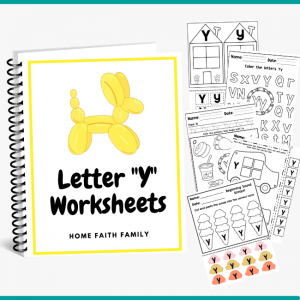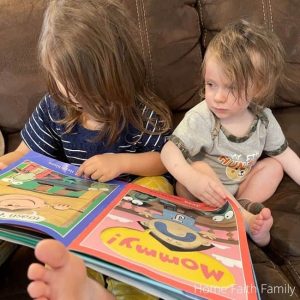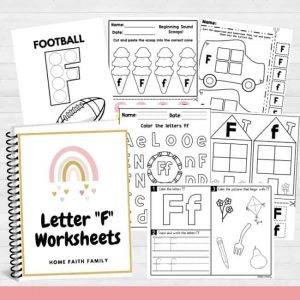Deciding to homeschool your kids is a big decision.
And once you’ve made that decision, there’s a lot of planning that goes into making it work.
One of the most important aspects of being a homeschool mom is creating a schedule that works for your family.

- How To Create A Homeschool Schedule That Works For Your Family
- Preschool Homeschool Schedule
- Kindergarten Homeschool Schedule
- 1st Grade Homeschool Schedule
- Want A Sneak Peek Into My Family’s Homeschool Day?
- A Schedule For Homeschooling Year Round
- Traditional Homeschool Block Schedule
- Homeschool Relaxed Schedule
- Homeschool Loop Schedule
- Sample Homeschool Schedule
- What To Do When Your Homeschool Schedule Isn’t Working
How To Create A Homeschool Schedule That Works For Your Family
There are a lot of factors to consider, including your kids’ ages and learning styles, your work schedule, and extracurricular activities.
Creating a schedule may seem daunting, but it doesn’t have to be.
By taking some time to think about your family’s needs and goals, you can create a homeschool daily schedule that will help everyone stay on track and make the most of your homeschooling experience.
Here are some tips to get you started and 3 different sample homeschool schedules you can draw inspiration from:
1. Start with the basics.
When creating your daily homeschool schedule, start with the basics.
Consider when everyone wakes up and goes to bed, when meals are eaten, and other daily routines.
Build your homeschooling schedule around these existing routines whenever possible.
This will help ease the transition for everyone involved and make it more likely that your schedule will be followed.
Don’t try to change your children’s natural routine to fit a homeschooling schedule.
2. Make time for subjects that take longer.
Some subjects, like math and reading, may take longer than others (and that’s perfectly normal).
Make sure to build in enough time for these subjects so that your child doesn’t feel rushed or overwhelmed.
Allowing extra time for difficult or challenging subjects will also give you ample opportunity to provide feedback and help as needed.
Here’s An Example of a Daily Homeschool Routine

6:30-8:00am: Wake up, morning prayers, Bible study
8:00-9:00am: Breakfast, personal hygiene, and prepare for school work
8:00-11:30am: Independent Work including subject areas of study: math, reading, science, language arts, history, etc.
11:30-12:00pm: Break
12:00-1:00pm: Lunch
1:00-3:00pm: Homeschool co-ops, park visits, field trips
3:00-4:00pm: Free time/extra activities
4:00-5:00pm: Help with dinner, complete family chores
5:00-6:00pm: Dinner
6:00-6:30pm: Family time, bedtime stories, reading
6:30-7:00pm: Family evening prayers, get ready for bed.
7:00-8:00pm: Quiet time in bedrooms (the younger ones go to sleep while my older children will journal, meditate, or read)
8:00pm: Bedtime
Of course, every family is different, so feel free to adjust this schedule as needed.
The important thing is that you create a schedule that works for you and your children.
3. Leave room for flexibility.
No matter how well you plan, there will always be days when things don’t go as planned.
Leave some wiggle room in your schedule so that you can accommodate unexpected disruptions without throwing off the entire day’s plans.
This flexibility will also give you the opportunity to take advantage of teachable moments as they arise throughout the day.
4. Take breaks throughout the day.
Just like traditional school students, homeschooled kids need some time to relax and rejuvenate between subject areas.
Plan for regular breaks throughout the day so that everyone has time to take a breather before diving back into academics.
These breaks can be used for snacks, outdoor play, or just some quiet down time–whatever works best for your child.
5. Make Time for Extra-Curricular Activities
Another benefit of homeschooling is that it frees up time for extra-curricular activities.
If your children are involved in sports or other activities, be sure to factor those into your homeschool schedule.
This will help ensure that they have the time they need to pursue their interests and still get a quality education.
6. End With Fun!
Let’s face it–kids (and adults!) learn better when they’re enjoying themselves.
So end each day on a positive note by scheduling some fun activities that everyone can look forward to.
This could be anything from watching a movie together to playing games as a family.
The important thing is that it’s something everyone will enjoy and looks forward to after a long day of learning at home.

Preschool Homeschool Schedule
After homeschooling four (soon to be five) preschoolers, I’ve found that a daily schedule is essential to our family’s sanity.
I don’t mind if we don’t stick to the schedule exactly, but it does help us stay on track and makes sure we get all of our bases covered.
Plus, my 4 year old knows what to expect each day and they like the predictability that comes with having a schedule.
Here’s a look at our daily preschool homeschool schedule:
6:30-8:00am: Wake up, morning prayers, Bible study
8:00-9:00am: Breakfast, personal hygiene, and prepare for school work
8:00-11:30am: Preschool homeschool curriculum: we use the Smart Little Learners Curriculum. After they complete their sheets they have plenty of time to learn through play
11:30-12:00pm: Break
12:00-1:00pm: Lunch
1:00-3:00pm: Homeschool co-ops, park visits, field trips
3:00-4:00pm: Free time/extra activities
4:00-5:00pm: Help with dinner, complete family chores
5:00-6:00pm: Dinner
6:00-6:30pm: Family time, bedtime stories, reading
6:30-7:00pm: Family evening prayers, get ready for bed.
7:00-8:00pm: Bedtime

Kindergarten Homeschool Schedule
Starting kindergarten is a big step for any child, and for many parents, it can be a bit daunting.
One question that often comes up is what the homeschool schedule should look like.
Here is a suggested homeschool schedule for kindergarten that will help you get started.
6:30-8:00am: Wake up, morning prayers, Bible study
8:00-9:00am: Breakfast, personal hygiene, and prepare for school work
8:00-11:30am: Subject areas of study including: math, reading, science, English, history, etc.*
11:30-12:00pm: Break
12:00-1:00pm: Lunch
1:00-3:00pm: Homeschool co-ops, park visits, field trips
3:00-4:00pm: Free time/extra activities
4:00-5:00pm: Help with dinner, complete family chores
5:00-6:00pm: Dinner
6:00-6:30pm: Family time, bedtime stories, reading
6:30-7:00pm: Family evening prayers, get ready for bed.
7:00-8:00pm: Bedtime
* My kindergarteners never sit for the full three and a half hours doing school work.
We break up our day with plenty of movement and hands-on activities, usually every 25-40 minutes depending on what they’re working on.
I would rather have them be engaged and learn a little bit each day than sit for long periods of time and be bored or frustrated.

1st Grade Homeschool Schedule
The first grade can be an exciting time for homeschoolers.
Students are usually beginning to read and write on their own, and they’re starting to explore more advanced math concepts.
Although each child is different, most first graders benefit from a relatively structured schedule.
A typical day might include time for reading, writing, math, science, and social studies.
Physical activity is also important, so students should have time for recess or other forms of exercise.
There’s no need to pack every minute of the day with schoolwork—a little free time each day can give children a chance to explore their interests or simply relax.
By following a well-rounded schedule, homeschoolers can ensure that their first graders are getting the education they need to thrive.
Want A Sneak Peek Into My Family’s Homeschool Day?
One thing homeschool moms often ask is, “What does a day in the life of a homeschooler look like?”
Here’s a peek into our homeschool day with grades 4, 2, 1, preschool, and a busy toddler, so you can get an idea of what it looks like in action.
Watch the video for a day in the life of our homeschool.
A Schedule For Homeschooling Year Round
There are many benefits to homeschooling year round.
First, it allows families to tailor their educational experience to their individual needs and schedules.
Your family’s schedule may not look the same each month.
You may decide to focus on curriculum work during the winter months and take advantage of the summer months by teaching through travel and fieldtrips.
Second, it can help students retain information better by providing shorter, more frequent academic sessions.
Finally, homeschooling year round can give students a chance to explore their interests in greater depth and to take advantage of opportunities as they arise.
Whatever the reason, homeschooling year round is an increasingly popular option for families across the country.
If you’re considering homeschooling, be sure to explore all of your options before making a decision.
With a little planning, you can ensure that your family has a positive and productive homeschooling experience.

Traditional Homeschool Block Schedule
The traditional homeschool block schedule has been a popular choice for families for many years.
This type of schedule typically involves four or five days of homeschooling, followed by a day or two off.
The advantage of this schedule is that it allows families to take advantage of extracurricular activities and social opportunities, while still providing a solid foundation in academics.
If you went to a public school you are most likely used to a five day school week, so this type of schedule may feel more familiar.
Advantages To Traditional Block Schedule
The most important advantage of this type of schedule is that it helps to ensure that all subjects are given the same amount of attention.
This can be especially helpful if you have a child who tends to struggle with one particular subject.
By having a set schedule, you can make sure that your child spends enough time on each subject and doesn’t get too far behind.
In addition, the block schedule can be customized to meet the unique needs of each family.
For example, some families may choose to homeschool four days a week and use the fifth day for field trips or other enrichment activities.
Others may opt to homeschool five days a week but take every other Friday off.
Ultimately, the traditional homeschool block schedule provides a great deal of flexibility, making it an ideal option for many families.
A Word of Caution About This Schedule
Just because the traditional homeschool block schedule is built similar to the public school system schedule, doesn’t mean that it is the best option for every family.
In fact, this type of schedule can be quite rigid and may not allow for the flexibility that many families need.
If you are feeling overwhelmed at the rigid 8:00am-3:00pm schedule, don’t worry, there are other options available.
Consider a more flexible schedule, such as the Relaxed Schedule or even homeschooling year round to meet the needs of your family.

Homeschool Relaxed Schedule
What is the homeschool relaxed schedule? This schedule is just what it sounds like- a more relaxed approach to homeschooling.
Families who follow this type of schedule typically have a more flexible approach to learning, often incorporating a mix of academics and life learning experiences.
This type of schedule is often less structured than the traditional homeschool block schedule and may involve more days spent learning outside of the home.
The relaxed schedule is a great option for families who want to take a more hands-on approach to learning.
Advantages To The Relaxed Schedule
One of the biggest advantages of the relaxed schedule is that it allows for more time spent on life learning experiences.
This type of schedule is often less structured.
For example, families on a relaxed schedule might spend one day each week visiting a local museum or going on a nature hike.
This type of schedule is also a great option for families who want to take advantage of opportunities as they arise.
Homeschool families don’t have to feel confined to an academic schedule, but can create a learning environment where children can thrive as they explore the world around them.
A Word of Caution About This Schedule
Although the relaxed schedule offers a great deal of flexibility, it is important to remember that this type of schedule can also be quite chaotic.
Families who follow a relaxed schedule often find that their days are filled with last-minute trips and spur-of-the-moment learning opportunities.
If you are the type of person who prefers a more structured day, the relaxed schedule may not be the best option for you.
In addition, families on a relaxed schedule often find it difficult to stick to a regular routine.
If you are looking for a more flexible approach to homeschooling but still want to maintain some structure in your day, you may want to consider finding a balance that’s perfect for your family’s needs between the traditional block schedule and the relaxed schedule.

Homeschool Loop Schedule
The Homeschool Loop Schedule is a system that helps you to keep track of your homeschool lessons.
It is based on a simple scheduling idea.
Loop scheduling doesn’t assign a particular subject to a particular day.
Instead, you have a list (loop) of work that you do during a certain time period.
When it is time to work, you simply move to the next subject on the list and start there.
This keeps you from getting bogged down in one subject for long periods of time and ensures that you cover all the material you need to.
The schedule is flexible, so you can adjust it to fit your family’s needs.
And it’s easy to use, so you can start using it right away.
Sample Homeschool Schedule
How you structure your homeschool day will depend on the ages and needs of your children, as well as your own teaching style.
I remember my first year homeschooling.
I felt like a hot-mess mama and had no idea what my kids should focus on, until I began using this homeschool planner printable and created a homeschool schedule that works for my family.

Here’s everything you’ll find inside:
- Year at a glance (Plan your child’s educational goals and measure growth with this year at a glance, so you know what they are learning and when.)
- 2023 dated monthly calendars
- Undated monthly calendars
- Weekly plans (Break down your child’s educational monthly goals into actionable steps using this weekly breakdown with your main goal, notes, to do list, and week overview.)
- Weekly overviews
- Weekly timetable
- Weekly lesson plans
- Daily overview (Sometimes you need those day-to-day actionable plans, and so does your child. You will love the space you have to write the time, subject, and check marks for your daily tasks. You’ll also find space to write your top priorities and to-do list.)
- Unit study activities
- Unit study prep
- Reading log
- Field trip log
- Attendance sheet
- Grade tracker
- Wish list
- and more!
You can take a look inside this comprehensive homeschool planner and get your schedule organized here.

What To Do When Your Homeschool Schedule Isn’t Working
It can be frustrating when you feel like your schedule isn’t working.
Maybe you’re struggling to get everything done in a day, or you’re constantly feeling stressed and overwhelmed.
If this sounds familiar, don’t worry – you’re not alone.
Here are some tips to help you get back on track:
1. Figure out what’s not working.
The first step is to identify what isn’t working with your current schedule.
Are you spending too much time on certain tasks?
Are there things that always seem to fall by the wayside?
Once you know what the problem areas are, you can start to make changes.
2. Simplify your schedule.
Sometimes the best solution is to simply simplify your schedule.
If you’re trying to cram too many things into a day, cut back and focus on the essentials.
This will help you to feel less overwhelmed and better able to stay on top of your commitments.
3. Be flexible.
Life doesn’t always go according to plan, so it’s important to be flexible with your schedule.
If something comes up that throws off your whole day, don’t be afraid to adjust accordingly.
This doesn’t mean that you should always be changing your plans, but it’s important to be flexible when necessary.
4. Take a break.
If you’re feeling really stressed out, it might be helpful to take a break from your regular routine.
This could mean taking a day off from lessons.
Your children can still learn through play and exploring the world around them.
Taking some time for yourself can help you to recharge and come back stronger than ever.
5. Ask for help.
If you’re struggling to manage everything on your own, don’t be afraid to ask for help from friends or family members.
You’re more than welcome to e-mail me or leave me a comment on this YouTube video. Let me know what you struggle with the most when it comes to homeschooling.
Making small changes to your schedule can make a big difference in how well it works for you.
So if you’re feeling frustrated, try some of these tips and see how they help!
Even though creating a schedule may seem daunting, it doesn’t have to be!

By taking some time to consider your family’s needs and goals, you can create a schedule that works for everyone involved in your homeschooling journey!
Remember to give yourself grace as you figure out what works best for your family, and don’t be afraid to make changes along the way.
After all, homeschooling is all about preparing your children for the real world, and that includes learning to be flexible!
For more homeschool resources check out our free early education content, or grab your next favorite printables in our shop.
You might also like:
- The debate over homeschool vs. public school is one that has been going on for years. There are pros and cons to both options, and ultimately it is up to the parents to decide what is best for their child. Here is the best advice for parents when they need to decide between homeschool vs public school for their child.
- Homeschooling can be a great option for parents who want to be more involved in their child’s education, and it can offer many benefits. However, it is important to do your research and make sure that homeschooling is the right fit for you and your family. Here are 12 reasons you need to homeschool your child.
- Homeschooling can be tough, but the days are also filled with hilarious moments. These funny homeschool memes perfectly capture the messy days and the tender moments of homeschooling your children.
- Art is an important part of education for children. It can help them develop their creativity and art skills that will last a lifetime. You want art supplies that are affordable, but also high-quality. Whether you are looking for art supplies for a specific project or just need some art supplies, this list of homeschool art supplies will help you get what you need!
- Homeschooling moms need to depend on God’s word as they teach their children. These Bible verses for homeschooling moms are encouraging and acknowledge our feelings and need to depend on the Lord.

Micah Klug is a wife, homeschooling mother to five children, and author. She teaches time-tested solutions to help parents remember what matters most in life, including strengthening their home, faith, and family relationships. To learn how a child who grew up in an authoritarian home is now creating an environment of peace and joy in her own home visit this page. If you want to contact Micah, send her an email here or email [email protected].









